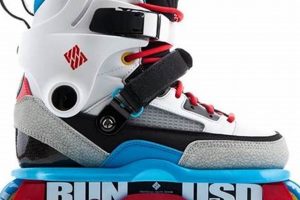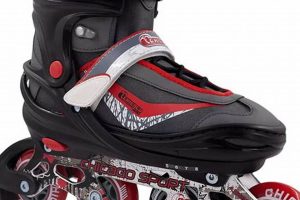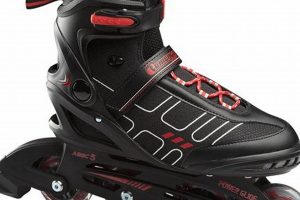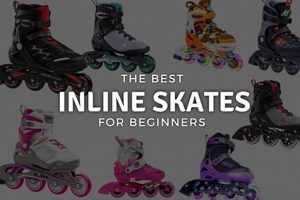These specialized recreational devices feature wheels arranged in a single line within a supportive frame, attached to a boot designed for foot enclosure. They are utilized for various activities including urban skating, freestyle, and fitness. As an example, individuals might use these skates for navigating city streets or performing tricks in a skate park.
The significance of this equipment lies in its versatility and potential for physical activity. Benefits include enhanced cardiovascular health, improved balance, and strengthened leg muscles. Historically, developments in materials and design have contributed to increased performance and comfort, expanding their appeal across different skill levels.
Further discussion will explore specific models, maintenance procedures, and considerations for selecting appropriate safety gear, providing a complete overview of this dynamic sporting equipment.
Essential Guidelines for Selection and Use
The following recommendations serve to enhance the user experience and safety during operation.
Tip 1: Selection based on Intended Use: The intended application of the equipment should dictate the model chosen. For example, a model with a higher cuff and more robust frame is preferable for aggressive skating, while a lower cuff and lighter frame may suit recreational use.
Tip 2: Proper Boot Fit: A snug, but not restrictive, fit is crucial. Ill-fitting boots can lead to discomfort, blisters, and reduced control. Measuring foot length and width, and consulting size charts specific to the manufacturer, is advisable.
Tip 3: Wheel Hardness and Size Considerations: Wheel durometer (hardness) and diameter influence speed and grip. Softer wheels (lower durometer) provide better grip but wear more quickly, while harder wheels offer greater speed. Larger diameter wheels are generally faster, but may sacrifice maneuverability.
Tip 4: Frame Material and Configuration: Frame material (aluminum or plastic) impacts weight and responsiveness. Aluminum frames are more rigid and durable, while plastic frames are typically lighter and more affordable. Frame configuration (flat, rockered, anti-rocker) affects maneuverability and suitability for different skating styles.
Tip 5: Bearing Maintenance: Regular cleaning and lubrication of bearings are essential for smooth rolling and extended lifespan. Remove bearings from wheels periodically, clean with a solvent, and re-lubricate with bearing oil or grease.
Tip 6: Safety Gear is Mandatory: Helmets, wrist guards, knee pads, and elbow pads are non-negotiable. Injuries are preventable with the consistent use of appropriate protective equipment.
Tip 7: Regular Inspection: Before each use, inspect the equipment for loose bolts, worn wheels, or damaged components. Addressing issues proactively minimizes the risk of accidents.
Adherence to these guidelines promotes safer operation, prolonged equipment life, and optimized performance.
The subsequent section will provide information on troubleshooting common issues and advanced techniques.
1. Frame Rigidity
Frame rigidity is a critical attribute influencing the performance characteristics of inline skates. It directly affects power transfer, responsiveness, and overall control, making it a central consideration in the design and selection process.
- Power Transfer Efficiency
A highly rigid frame minimizes energy loss during push-off. The skater’s applied force is channeled more directly into forward momentum, rather than being absorbed by frame flex. This translates to increased speed and reduced fatigue over extended skating sessions. For example, an aluminum frame typically exhibits greater rigidity than a composite frame, resulting in a more efficient skating experience for advanced users.
- Responsiveness and Maneuverability
The responsiveness of the skates to directional changes is directly linked to frame rigidity. A stiffer frame allows for quicker and more precise turns. This is particularly important for freestyle skating and navigating urban environments. Less rigid frames may exhibit a delayed or less predictable response, potentially compromising control.
- Impact Absorption and Vibration Dampening
While rigidity is crucial for power transfer, excessive stiffness can reduce impact absorption. Softer materials or frame designs with built-in flex points can help mitigate vibrations and lessen the impact on joints, particularly when skating on rough surfaces. Finding the right balance between rigidity and dampening is key for a comfortable and efficient skating experience.
- Material Properties and Construction Techniques
The material used and the manufacturing process employed significantly impact frame rigidity. Extruded aluminum frames offer a high strength-to-weight ratio, providing excellent rigidity and durability. Composite frames, on the other hand, can be molded into complex shapes and offer varying degrees of flex. The choice of material and construction technique should align with the intended use of the skates.
In conclusion, frame rigidity is a multifaceted factor influencing the performance, control, and comfort. Selection necessitates careful consideration of skating style, skill level, and desired skating environment. Higher performance is generally achieved with high rigidity while comfort may be prioritized with some dampening considerations.
2. Wheel Durometer
Wheel durometer, a measure of a wheel’s hardness, is a crucial consideration in the selection and use of FR inline skates. It dictates the balance between grip, speed, and durability, significantly influencing skating performance across various terrains and styles.
- Grip and Control
Lower durometer wheels (e.g., 82A-85A) offer increased grip, particularly on smooth surfaces. This enhances control during maneuvers, such as turns and slides, making them suitable for freestyle skating and beginners. The softer compound deforms more readily, increasing the contact area with the ground. For example, a skater performing a powerslide benefits from the enhanced grip of a lower durometer wheel, preventing unwanted slippage.
- Speed and Rolling Efficiency
Higher durometer wheels (e.g., 86A-90A) provide greater speed and rolling efficiency due to their reduced deformation. These are favored for long-distance skating and speed skating, where minimizing rolling resistance is paramount. The harder compound maintains its shape better, resulting in less energy loss. An urban skater covering long distances may prefer harder wheels for the increased speed and reduced effort.
- Durability and Wear Resistance
Wheel durometer also impacts the lifespan of the wheels. Softer wheels wear down more quickly, especially on abrasive surfaces. Harder wheels are more resistant to wear and tear, making them a better choice for rough terrain and frequent use. A skater frequently skating on asphalt will find that harder wheels last significantly longer than softer wheels.
- Surface Compatibility
The ideal wheel durometer depends heavily on the skating surface. Smooth surfaces allow for the use of harder wheels to maximize speed, while rough surfaces necessitate softer wheels for better grip and vibration absorption. A skater transitioning from an indoor rink (smooth surface) to outdoor asphalt (rough surface) should consider switching to wheels with a lower durometer for improved control and comfort.
The selection of appropriate wheel durometer for FR inline skates is a balance of grip, speed, durability, and surface conditions. Skaters should assess their skating style and the environments they typically skate in to make an informed decision. Experimentation with different durometers is recommended to determine the optimal configuration for individual needs.
3. Boot Support
Boot support, a fundamental aspect of FR inline skates, directly influences stability, control, and overall skating performance. The design and construction of the boot determine the degree to which the ankle and lower leg are supported, thereby affecting the skater’s ability to execute maneuvers, maintain balance, and prevent injuries. Insufficient boot support can lead to ankle instability, increasing the risk of sprains and compromising the skater’s ability to generate power efficiently. Conversely, excessive support can restrict movement and hinder agility. For instance, a skater performing aggressive tricks requires a boot with robust lateral support to withstand the forces generated during jumps and landings; a recreational skater may prioritize a more flexible boot for enhanced comfort and ease of movement.
The materials used in boot construction significantly impact the level of support provided. Carbon fiber boots, known for their stiffness and lightweight properties, offer superior support and responsiveness, making them suitable for advanced skaters and competitive applications. Conversely, softer materials like synthetic leather or molded plastics provide greater flexibility and comfort, catering to recreational and fitness skating. The closure system, including buckles, laces, and power straps, further enhances boot support by securing the foot and ankle within the boot. A well-designed closure system distributes pressure evenly, preventing slippage and maximizing control. Adjustable cuff systems also permit customization of support levels to suit individual preferences and skating styles. Incorrect support can lead to over pronation or supination of the ankle, potentially leading to long term strain and injury.
In summary, boot support is an indispensable element of FR inline skates, critical for optimizing performance, ensuring safety, and enhancing comfort. Skaters must carefully consider their skill level, skating style, and desired level of support when selecting skates. A proper assessment of boot fit and construction, coupled with appropriate adjustment of the closure system, is essential for maximizing the benefits of boot support and minimizing the risk of injury. As the foot and ankle work as a biomechanical unit, proper support can help prevent knee and hip injuries as well.
4. Bearing Precision
Bearing precision directly influences the rolling efficiency and overall performance of FR inline skates. Bearings, housed within the wheels, facilitate smooth rotation around the axle. Higher precision bearings minimize friction, allowing wheels to spin more freely and for longer durations with each push. This translates to increased speed, reduced effort, and improved energy conservation for the skater. For example, a skater using FR inline skates equipped with high-precision bearings may experience a noticeable difference in glide distance compared to skates with lower-precision bearings, requiring fewer pushes to maintain a given speed. The ABEC (Annular Bearing Engineering Committee) rating system is commonly used to quantify bearing precision, with higher numbers indicating tighter tolerances and reduced friction.
The practical significance of bearing precision extends beyond mere speed enhancement. Enhanced rolling efficiency contributes to improved control and maneuverability, particularly at higher speeds. Skaters using FR inline skates for freestyle or aggressive skating benefit from the responsiveness and predictability afforded by high-precision bearings. Furthermore, reduced friction translates to less heat buildup within the bearings, prolonging their lifespan and minimizing maintenance requirements. Real-world examples demonstrate that bearings with lower precision ratings are more susceptible to wear and damage, necessitating more frequent replacement and potentially compromising skating performance over time. The choice of bearing precision should align with the skater’s skill level, intended use, and budget.
In summary, bearing precision is a crucial determinant of performance and longevity in FR inline skates. The selection of bearings with appropriate precision levels optimizes rolling efficiency, enhances control, and minimizes maintenance needs. Skaters must consider their specific requirements and skating style to make an informed decision, acknowledging that higher precision generally corresponds to increased cost but also yields tangible benefits in terms of performance and durability. Understanding the role of bearing precision contributes to a more informed approach to equipment selection and maintenance, ultimately enhancing the overall skating experience.
5. Closure System
The closure system is a critical component of FR inline skates, responsible for securing the foot within the boot and influencing fit, comfort, and performance. Different closure mechanisms offer varying degrees of adjustability, support, and ease of use, thereby impacting the overall skating experience. Understanding the nuances of these systems is essential for selecting skates that meet individual needs and preferences.
- Buckle Systems
Buckle systems, often incorporating ratchet mechanisms, provide a secure and adjustable fit, particularly around the ankle and upper cuff. These systems allow for quick adjustments and are commonly found on skates designed for aggressive skating and freestyle, where firm support is crucial. A micro-adjustable buckle enables fine-tuning of the fit for enhanced comfort and performance during dynamic movements.
- Lace Systems
Lace systems offer a highly customizable fit throughout the entire foot. The skater can adjust the tightness of the laces in different areas to accommodate variations in foot shape and volume. Skates designed for recreational and fitness skating often feature lace systems, as they prioritize comfort and flexibility. The use of waxed laces can enhance security and prevent slippage during skating.
- Power Straps
Power straps, typically made of Velcro or similar materials, provide additional support and closure across the instep. These straps help to secure the heel within the boot, preventing lift and improving power transfer. Skates designed for urban skating and slalom often incorporate power straps to enhance control and responsiveness. Proper tightening of the power strap ensures optimal foot stabilization and reduces the risk of blisters.
- Boa Systems
Boa systems utilize a dial and cable mechanism to provide precise and even closure throughout the boot. This system allows for quick and effortless adjustments, even while skating. Boa systems are increasingly found on high-end skates, offering a combination of convenience, comfort, and performance. The micro-adjustability of the Boa system ensures a secure and customized fit for various foot shapes.
The choice of closure system on FR inline skates depends on the skater’s priorities, skating style, and foot anatomy. A well-chosen and properly adjusted closure system enhances comfort, improves control, and optimizes performance, ultimately contributing to a more enjoyable and safe skating experience. Hybrid systems combining multiple closure mechanisms are also common, offering a balance of adjustability, support, and ease of use.
6. Skating Discipline
The specific application, or skating discipline, heavily influences the optimal selection and configuration of FR inline skates. The demands of different skating styles necessitate variations in boot construction, frame design, wheel specifications, and bearing precision.
- Urban Skating/Freeride
This discipline emphasizes agility, durability, and versatility for navigating city environments. FR inline skates designed for urban skating typically feature robust boots with reinforced ankle support, short frames for maneuverability, and wheels with moderate durometer for grip and wear resistance. A skater traversing uneven surfaces or performing quick turns benefits from this configuration.
- Freestyle/Slalom
Freestyle skating demands precision, responsiveness, and control for executing intricate maneuvers around cones. FR inline skates for freestyle often have shorter, more maneuverable frames, rockered wheel setups to facilitate pivoting, and boots with enhanced lateral support. Bearings with high precision are preferred to maximize rolling efficiency and responsiveness.
- Aggressive Skating
Aggressive skating involves performing tricks on ramps, rails, and other obstacles, requiring extreme durability and impact resistance. FR inline skates for aggressive skating typically feature reinforced boots, grind blocks for sliding, and smaller, harder wheels for durability and control. A flat or anti-rocker wheel setup is common to aid in grinding maneuvers.
- Fitness/Speed Skating
Fitness skating prioritizes comfort, efficiency, and speed for long-distance skating or exercise. FR inline skates designed for fitness may incorporate a longer frame for increased stability and speed, larger diameter wheels to reduce rolling resistance, and a more breathable boot for comfort. Higher precision bearings enhance rolling efficiency and reduce fatigue.
The selection of appropriate FR inline skates is contingent upon a thorough understanding of the intended skating discipline. Each style presents unique demands, necessitating specific features and configurations to optimize performance, ensure safety, and maximize enjoyment. Considering the intended application is paramount to achieving the desired outcome.
Frequently Asked Questions about FR Inline Skates
The following questions address common inquiries regarding FR inline skates, providing clarity on their features, usage, and maintenance.
Question 1: What distinguishes FR inline skates from other brands?
FR inline skates are generally recognized for their focus on durability, performance, and versatility, catering to diverse skating styles from urban and freestyle to fitness and aggressive skating. They often feature robust construction and customizable components.
Question 2: How should one determine the correct size when purchasing FR inline skates?
Accurate foot measurement is crucial. Consult the manufacturer’s sizing chart, comparing foot length (and, if available, width) to the specified measurements. Account for sock thickness and consider the intended use; aggressive skating may necessitate a tighter fit than recreational skating.
Question 3: What are the key maintenance procedures for FR inline skates?
Regular maintenance includes cleaning and lubricating bearings, inspecting and tightening bolts, rotating or replacing worn wheels, and ensuring the proper functionality of the closure system. Prompt attention to these areas prolongs equipment lifespan and optimizes performance.
Question 4: Can the frames on FR inline skates be replaced or upgraded?
Yes, frame replacement and upgrades are frequently possible, allowing skaters to customize their setup for specific skating styles or performance enhancements. Ensure compatibility with the boot mounting system before undertaking a frame replacement.
Question 5: What is the recommended safety gear when using FR inline skates?
Helmets are essential. Wrist guards, knee pads, and elbow pads are highly recommended to mitigate the risk of injury. Adherence to safety gear guidelines is critical for all skill levels and skating environments.
Question 6: How does wheel durometer affect the performance of FR inline skates?
Wheel durometer, a measure of hardness, influences grip, speed, and durability. Softer wheels (lower durometer) provide greater grip but wear faster, while harder wheels offer increased speed and longevity. The appropriate durometer depends on the skating surface and intended style.
These FAQs provide a foundational understanding of FR inline skates. Consulting manufacturer resources and expert advice further enhances informed usage.
The following segment details specific component selection recommendations based on skating style.
In Summary
The preceding discussion has elucidated key aspects of FR inline skates, encompassing selection guidelines, maintenance procedures, component considerations, and discipline-specific configurations. Frame rigidity, wheel durometer, boot support, bearing precision, and closure systems were addressed, underscoring their individual and collective influence on skating performance and safety. Furthermore, common queries regarding these skates were addressed, providing practical insights for potential and current users.
The informed application of this knowledge empowers individuals to optimize their skating experience, facilitating enhanced performance, prolonged equipment lifespan, and mitigated risk of injury. Continued adherence to best practices and ongoing exploration of advanced techniques will further elevate competence and enjoyment within this dynamic activity. The commitment to responsible and knowledgeable engagement ensures the sustained growth and appreciation of the FR inline skating community.




![Best Chicago Skates Inline Skates: [Year] Guide & More! Safem Fabrication - Precision Engineering & Custom Manufacturing Solutions Best Chicago Skates Inline Skates: [Year] Guide & More! | Safem Fabrication - Precision Engineering & Custom Manufacturing Solutions](https://cruzskateshop.com/wp-content/uploads/2025/06/th-3478-300x200.jpg)


